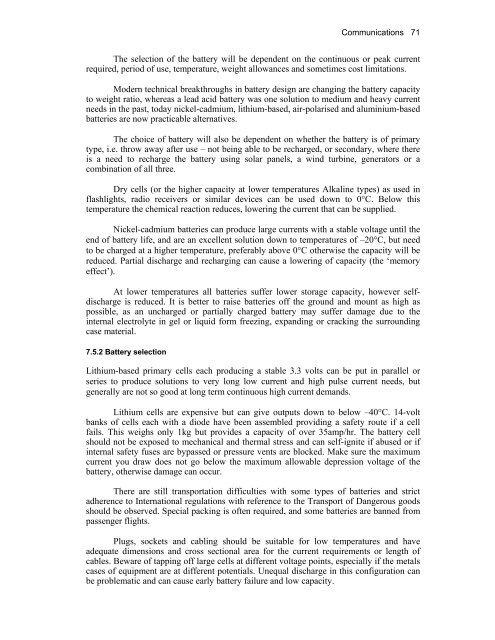Edited by Rachel Duncan 4th Edition ISBN 0-907649-91-2 London ...
Edited by Rachel Duncan 4th Edition ISBN 0-907649-91-2 London ...
Edited by Rachel Duncan 4th Edition ISBN 0-907649-91-2 London ...
You also want an ePaper? Increase the reach of your titles
YUMPU automatically turns print PDFs into web optimized ePapers that Google loves.
Communications 71<br />
The selection of the battery will be dependent on the continuous or peak current<br />
required, period of use, temperature, weight allowances and sometimes cost limitations.<br />
Modern technical breakthroughs in battery design are changing the battery capacity<br />
to weight ratio, whereas a lead acid battery was one solution to medium and heavy current<br />
needs in the past, today nickel-cadmium, lithium-based, air-polarised and aluminium-based<br />
batteries are now practicable alternatives.<br />
The choice of battery will also be dependent on whether the battery is of primary<br />
type, i.e. throw away after use – not being able to be recharged, or secondary, where there<br />
is a need to recharge the battery using solar panels, a wind turbine, generators or a<br />
combination of all three.<br />
Dry cells (or the higher capacity at lower temperatures Alkaline types) as used in<br />
flashlights, radio receivers or similar devices can be used down to 0°C. Below this<br />
temperature the chemical reaction reduces, lowering the current that can be supplied.<br />
Nickel-cadmium batteries can produce large currents with a stable voltage until the<br />
end of battery life, and are an excellent solution down to temperatures of –20°C, but need<br />
to be charged at a higher temperature, preferably above 0°C otherwise the capacity will be<br />
reduced. Partial discharge and recharging can cause a lowering of capacity (the ‘memory<br />
effect’).<br />
At lower temperatures all batteries suffer lower storage capacity, however selfdischarge<br />
is reduced. It is better to raise batteries off the ground and mount as high as<br />
possible, as an uncharged or partially charged battery may suffer damage due to the<br />
internal electrolyte in gel or liquid form freezing, expanding or cracking the surrounding<br />
case material.<br />
7.5.2 Battery selection<br />
Lithium-based primary cells each producing a stable 3.3 volts can be put in parallel or<br />
series to produce solutions to very long low current and high pulse current needs, but<br />
generally are not so good at long term continuous high current demands.<br />
Lithium cells are expensive but can give outputs down to below –40°C. 14-volt<br />
banks of cells each with a diode have been assembled providing a safety route if a cell<br />
fails. This weighs only 1kg but provides a capacity of over 35amp/hr. The battery cell<br />
should not be exposed to mechanical and thermal stress and can self-ignite if abused or if<br />
internal safety fuses are <strong>by</strong>passed or pressure vents are blocked. Make sure the maximum<br />
current you draw does not go below the maximum allowable depression voltage of the<br />
battery, otherwise damage can occur.<br />
There are still transportation difficulties with some types of batteries and strict<br />
adherence to International regulations with reference to the Transport of Dangerous goods<br />
should be observed. Special packing is often required, and some batteries are banned from<br />
passenger flights.<br />
Plugs, sockets and cabling should be suitable for low temperatures and have<br />
adequate dimensions and cross sectional area for the current requirements or length of<br />
cables. Beware of tapping off large cells at different voltage points, especially if the metals<br />
cases of equipment are at different potentials. Unequal discharge in this configuration can<br />
be problematic and can cause early battery failure and low capacity.

















